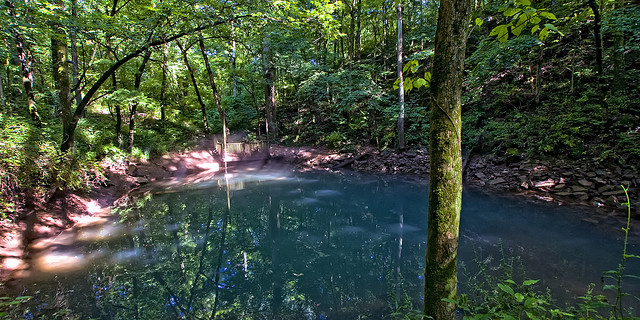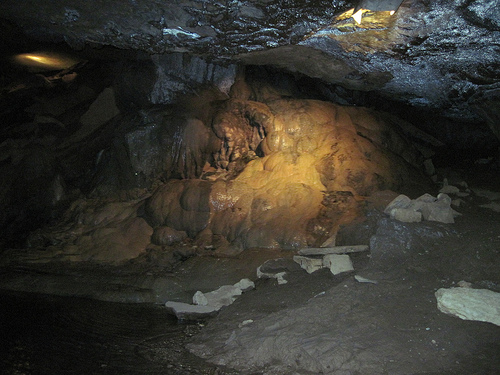


Location: Bowling Green, Kentucky Map
Lost River Cave, often simply referred to as Lost Cave by locals and visitors, is a captivating seven-mile-long karst cave system and 72-acre urban nature preserve located at 2818 Nashville Road in Bowling Green, Warren County, Kentucky, just an hour north of Nashville, Tennessee. Nestled along the northern edge of the city, it is jointly managed by the non-profit Friends of Lost River (established in 1990) and Western Kentucky University, serving as a vital educational and recreational hub that blends natural wonder with human history. The cave's namesake Lost River—recognized by Ripley's Believe It or Not as the "shortest and deepest river in the world"—sinks into the earth at a blue hole near the entrance, vanishes underground for over three miles, and reemerges downstream, creating a mysterious, subterranean waterway that maintains a constant 57°F (14°C) year-round. This unique feature powers Kentucky's only underground boat tour, a 45-minute guided experience that draws families, adventurers, and history buffs to explore its depths. The surrounding park encompasses over two miles of scenic wooded trails, a seasonal butterfly habitat, ziplining adventures, a treetop bridge, and educational facilities like the Nature Explore Outdoor Classroom and Playscape, attracting around 100,000 visitors annually. As of September 2025, the cave and park are fully operational and open year-round (except major holidays), with no active closures reported despite occasional tour cancellations due to heavy rain or flooding risks—visitors are advised to call ahead at (270) 393-0077 to confirm boat tour availability. The site emphasizes environmental education, wildlife conservation, and cultural preservation, offering a serene escape amid Bowling Green's vibrant college-town energy, home to Western Kentucky University.
Lost River Cave exemplifies classic karst topography in the Pennyroyal Plateau physiographic region of south-central Kentucky, where soluble limestone bedrock has been sculpted by water over millions of years into sinkholes, springs, and subterranean passages. The cave system stretches approximately seven miles, with the river entering via a dramatic blue hole—a 15-foot-deep (4.6 m) circular pool at the entrance that appears deceptively bottomless due to its connection to an underground extension, historically mismeasured at 437 feet (133 m) deep before plumb bobs were dragged by the current. The river flows intermittently above ground in three short surface sections before plunging into the cave, where it maintains a uniform, steady flow along much of its length, punctuated by older, higher passages that flood during heavy rains. The geology dates to the Mississippian Period (about 358–323 million years ago), when the area was a shallow tropical sea depositing layers of Lost River Chert (a hard, flint-like silica rock used by Native Americans for tools) overlain by Ste. Genevieve and St. Louis Limestones—soft, fossil-rich beds that dissolve in acidic rainwater to form the cave's chambers, scalloped walls, and undercut benches. Detached chert blocks from the dissolving limestone create natural detention basins or "backwaters" that slow water flow, while talus-like debris and scalloped erosion patterns add to the cave's labyrinthine beauty. The surrounding 72-acre park features rolling wooded hills, riparian wetlands, and open meadows typical of the Western Coal Field ecoregion, with elevations around 550–600 feet (168–183 m) above sea level. Flooding from the river, which can rise rapidly after storms, occasionally impacts accessibility, but engineered wetlands help filter stormwater and mitigate erosion. The cave's entrance is framed by a historic stone dam from the 19th-century mills, now a picturesque overlook blending natural and human-engineered elements.
Human interaction with Lost River Cave spans over 10,000 years,
beginning with Paleo-Indian hunters at the end of the last Ice Age
(around 8,000 B.C.), who used Clovis spear points to hunt megafauna like
woolly mammoths, mastodons, and giant ground sloths, likely wintering in
the cave for its shelter, constant temperature, and reliable water
source. Archaeological evidence, including a rare in-situ Dalton point
dated to about 8,000 years ago, marks the site as significant for
studying the Archaic Period's transition to more organized resource use,
with continuous occupation until around 1,000 B.C. Native American
groups, including possible Shawnee or Cherokee influences, exploited the
chert for tools, leaving behind artifacts that underscore the cave's
role as a resource hub.
European settlement in the late 18th century
transformed the site into an industrial powerhouse due to its proximity
to Bowling Green and the Louisville-Nashville Turnpike. The first mill,
a corn gristmill and sawmill, may date to 1792, but by 1825, James
Skiles operated a flour mill powered by the river. In the mid-1870s,
John L. Row built a stone dam and ran a distillery and flour mill until
1889, followed by Robert Crump's operations until a 1915 fire destroyed
the last mill—Shank's Mill, famously the only underground water mill in
the U.S. by 1917. During the Civil War (1861–1865), the cave and valley
were a strategic point: Confederates controlled it from September 1861
to February 1862, followed by Union forces camping up to 40,000 troops
nearby; soldiers inscribed names, ranks, and units on the walls, and
Union bullets have been found inside, fueling legends like John Hunt
Morgan hiding there after raiding a train depot (though Union presence
makes this dubious). Post-war, rumors persisted of moonshining during
Prohibition (1920–1933), but no evidence confirms alcohol production in
the cave.
The 20th century saw recreational and commercial evolution:
In 1934, amid the Great Depression, it became the Cavern Nite Club, an
underground speakeasy-turned-nightclub with a stage, bar, dance floor,
and water-wheel-generated electricity, billed as the "only
air-conditioned nightclub in the U.S." by Billboard in 1939. It hosted
stars like Dinah Shore and the NBC Orchestra, with legends of Jesse
James using the cave as a hideout adding allure. The club closed in 1962
due to declining patronage and structural concerns, leading to decades
of neglect and use as an illegal dump by the 1980s. Restoration began in
1990 with the Friends of Lost River non-profit, funded by community
efforts and grants; the site reopened to the public in 1997 after
cleanup, stabilization, and the addition of educational programs. Today,
the preserved ballroom (seating 300) hosts events, symbolizing the
cave's shift from industrial relic to cultural treasure.
Lost River Cave's ecosystem thrives in its stable, humid microclimate, supporting a mix of aquatic, subterranean, and terrestrial species adapted to the karst environment. The underground river hosts blind cave fish (like the southern cavefish, Typhlichthys subterraneus), crayfish, and insects such as cave crickets and springtails, which form the base of a troglobitic (cave-adapted) food web reliant on organic detritus washed in from the surface. Bats, including the endangered Indiana bat (Myotis sodalis) and little brown bat (Myotis lucifugus), roost in the cave's upper passages, using it as a hibernation site during winter; conservation efforts monitor white-nose syndrome impacts. The surface park's wetlands and trails harbor diverse flora: native wildflowers, ferns, and trees like sycamore, river birch, and oak-hickory forest, with ongoing removal of invasive species such as Japanese honeysuckle and garlic mustard to restore balance. The seasonal Butterfly Habitat (open May–September) features native butterflies like monarchs and swallowtails in a screened enclosure with nectar plants, educating visitors on pollination. Birdwatching stations along the trails spot over 100 species, including woodpeckers, warblers, herons, and bald eagles near the river. Amphibians (salamanders, frogs) and reptiles (turtles, snakes) frequent the wetlands, while mammals like deer, foxes, raccoons, and beavers roam the woods. Educational programs, like bird bingo and geocaching, highlight biodiversity, with constructed wetlands filtering stormwater to protect water quality. The site's urban-adjacent location makes it a crucial green corridor, but threats like flooding and pollution from nearby development are managed through volunteer-led restoration.
Lost River Cave is a family-oriented destination with diverse,
low-to-moderate intensity activities integrated into Bowling Green's
tourism scene, often bundled with nearby attractions like Mammoth Cave
National Park (an hour away) or the National Corvette Museum. The
flagship offering is the 45-minute Historic Underground Boat Tour ($25
adults, $15 children 3–12, free under 3; runs 10 a.m.–4 p.m. daily,
weather permitting), where visitors walk a short trail to the entrance,
board flat-bottom boats (powered by electric motors for minimal
disturbance), and glide 1,000 feet into the cave, ducking under the
low-ceiling "Wishing Rock" section (20 seconds each way, potentially
claustrophobic). Guides use flashlights to illuminate formations,
sharing tales of history, geology, and legends, with a musty scent from
life preservers (required for kids under 12) adding authenticity.
Reviews rave about engaging guides (e.g., Sophie, Trevor, Olivia) who
entertain all ages with humor and facts, rating it 4.6/5 overall for its
uniqueness and value, though some note the $25 price feels steep for the
short duration and artificial damming.
Beyond the cave, the 72-acre
park boasts two miles of easy-to-moderate nature trails (free after
Visitor Center check-in, 8:30 a.m.–6:30 p.m. daily), including the Blue
Hole Trail for overlooks and the Wetlands Boardwalk for birding.
Ziplining (the only in Bowling Green) offers five lines over the
treetops ($50–$60, ages 7+), while the Treetop Bridge provides elevated
canopy walks. The seasonal Butterfly Habitat ($5 add-on) delights with
fluttering natives, and the Gemstone Sluice ($8–$10) lets kids "mine"
for souvenirs. The Nature Explore Outdoor Classroom features interactive
stations for sensory play and environmental learning, ideal for school
groups, with programs like the Young Interpreters (kids leading tours).
Additional perks include picnicking, geocaching, and the Wildflower
Gifts shop selling fossils, jewelry, and Kentucky souvenirs.
Well-behaved dogs are welcome on trails, and accessibility includes
paved paths and wheelchair-friendly boats (advance notice required).
Special events fill the calendar: summer kids' camps, fall Discovery
Cave Crawls (crawling tours with gear, limited fall/winter/spring),
holiday lights, and weddings in the chandelier-lit Ballroom. Visitor
feedback from 2025 highlights family fun and educational value but
cautions about summer heat (trails can be muggy) and rain-related
cancellations. The site generates economic impact through tourism, with
packages combining it with Corvette tours or downtown Bowling Green.
Designated a protected nature preserve since its 1997 reopening, Lost River Cave operates under the Friends of Lost River's stewardship, with Western Kentucky University providing academic support for research and education. The non-profit's mission—"to educate, enrich, and empower lives through connections with nature"—drives initiatives like invasive plant removal, bat monitoring, and wetland construction for stormwater management, funded by donations, grants, and volunteer hours (thousands annually). As a karst feature, it falls under Kentucky's broader cave protection laws, prohibiting vandalism or unauthorized entry to safeguard archaeological sites and fragile ecosystems. Collaborations with the U.S. Fish and Wildlife Service address endangered species like the Indiana bat, while the site's urban setting amplifies its role in biodiversity conservation amid development pressures. Recent updates include enhanced event venues (e.g., the River Birch Meeting Room for 50 guests) and sustainability practices like electric boat motors. Challenges like flooding (from the river's rapid rise) and urban runoff are met with adaptive management, ensuring the cave's legacy as a "hidden gem" endures for future generations, blending adventure with stewardship in the heart of Kentucky's cave country.